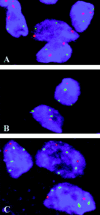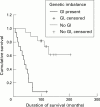Prediction of prognosis in patients with uveal melanoma using fluorescence in situ hybridisation
- PMID: 11734517
- PMCID: PMC1723818
- DOI: 10.1136/bjo.85.12.1440
Prediction of prognosis in patients with uveal melanoma using fluorescence in situ hybridisation
Abstract
Background/aims: Uveal melanoma is the commonest malignancy of the eye, with a high proportion of patients dying of metastatic disease. Tumours showing a loss of chromosome 3 and gains of chromosome 8 are associated with a worse prognosis. The efficiency of fluorescence in situ hybridisation (FISH) in determining copy numbers of these chromosomes was assessed in individual tumours and related to patient survival.
Methods: 33 fresh frozen samples were analysed with centromeric probes for chromosomes 3 and 8. Patient outcomes were divided into two groups: (1) absence of genetic abnormalities (no genetic imbalance) and (2) presence of genetic abnormalities (genetic imbalance). The log rank test was used to compare survival, which was represented by Kaplan-Meier survival curves.
Results: Of the 33 tumours analysed, 16 showed evidence of genetic imbalances. Of these 16 tumours, 14 patients had died by the end of the study, with 10 having died of liver metastases. Of the tumours without evidence of genetic imbalances, five patients had died by the end of the study, although none had died as a result of either liver metastases or from the primary uveal melanoma. The difference in survival between the two groups was highly significant (p<0.0001).
Conclusion: The authors have shown that FISH analysis for chromosome 3 and 8 is a reliable and efficient technique in the analysis of fresh frozen tumour specimens and is valuable in the prediction of prognosis in individuals with uveal melanomas.
Figures



Similar articles
-
Cytogenetics and prognosis for uveal melanoma in Korean patients.Acta Ophthalmol. 2011 Jun;89(4):e310-4. doi: 10.1111/j.1755-3768.2010.02099.x. Epub 2011 Feb 11. Acta Ophthalmol. 2011. PMID: 21310015
-
Detection of genetic prognostic markers in uveal melanoma biopsies using fluorescence in situ hybridization.Clin Cancer Res. 2002 Feb;8(2):534-9. Clin Cancer Res. 2002. PMID: 11839674
-
Concomitant loss of chromosome 3 and whole arm losses and gains of chromosome 1, 6, or 8 in metastasizing primary uveal melanoma.Invest Ophthalmol Vis Sci. 2001 Feb;42(2):313-7. Invest Ophthalmol Vis Sci. 2001. PMID: 11157859
-
[Genomic techniques used in uveal melanoma: a literature review].J Fr Ophtalmol. 2011 Apr;34(4):259-64. doi: 10.1016/j.jfo.2010.11.012. J Fr Ophtalmol. 2011. PMID: 21439677 Review. French.
-
Monosomy 3 by FISH in uveal melanoma: variability in techniques and results.Surv Ophthalmol. 2012 Sep;57(5):463-73. doi: 10.1016/j.survophthal.2011.12.004. Epub 2012 Jun 2. Surv Ophthalmol. 2012. PMID: 22658782 Review.
Cited by
-
Hindsight: Review of Preclinical Disease Models for the Development of New Treatments for Uveal Melanoma.J Cancer. 2021 Jun 4;12(15):4672-4685. doi: 10.7150/jca.53954. eCollection 2021. J Cancer. 2021. PMID: 34149931 Free PMC article. Review.
-
Genetics and RNA Regulation of Uveal Melanoma.Cancers (Basel). 2023 Jan 26;15(3):775. doi: 10.3390/cancers15030775. Cancers (Basel). 2023. PMID: 36765733 Free PMC article. Review.
-
Resistance of uveal melanoma to the interstrand cross-linking agent mitomycin C is associated with reduced expression of CYP450R.Br J Cancer. 2011 Mar 29;104(7):1098-105. doi: 10.1038/bjc.2011.56. Epub 2011 Mar 8. Br J Cancer. 2011. PMID: 21386838 Free PMC article.
-
The identification of chromosome abnormalities associated with the invasive phenotype of uveal melanoma in vitro.Clin Exp Metastasis. 2005;22(2):107-13. doi: 10.1007/s10585-005-5142-2. Clin Exp Metastasis. 2005. PMID: 16086231
-
A prognostic test to predict the risk of metastasis in uveal melanoma based on a 15-gene expression profile.Methods Mol Biol. 2014;1102:427-40. doi: 10.1007/978-1-62703-727-3_22. Methods Mol Biol. 2014. PMID: 24258991 Free PMC article.
References
Publication types
MeSH terms
LinkOut - more resources
Full Text Sources
Other Literature Sources
Medical
